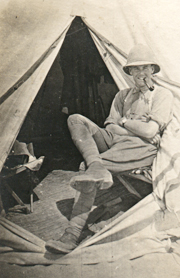We left the hotel at nine and took a motor to Giza; there we got onto camels and took a guide on a donkey and rode up to the Pyramids. We climbed the Pyramid of Giza, well worth doing, as the view from the top looking over the Nile valley is lovely. It wasn't difficult as far as the climbing went, but very hard work as it is 450 ft high. When you are climbing it doesn't seem to slope out as you'd expect, but looks absolutely sheer. Then we rode round the Sphinx and after that rode out to the pyramids and tombs of Sakkara which are nine miles away over the desert. It was really quite comfortable on the camels, and the motion not at all bad, but a bit jolty when we trotted. We passed a large herd of grazing camels, with several foals with them, though there wasn't a lot to graze on.
When we got to Sakkara we went down into the Temple of Teti, and underground vaults with a lot of Egyptian carving on the walls. Then we went down into the tomb of the Sacred Bull, very large underground tunnels and chambers. You have to take candles down. There were a good many enormous polished and carved coffins of granite. The sides were about a foot thick, the mummies had been taken out of them and are in the Cairo museum. Then we went into the Pyramid of Unas; you had to crawl down an underground passage about four feet high which branched into various chambers with the walls covered with carvings of quaint Egyptian figures. The most interesting of the Sakkara pyramids is the Pyramid of the Steps, though you can't climb it; it is six thousand years old.
After that we stopped for a bit to eat our sandwiches and then rode to Memphis and saw a Sphinx which was only discovered three years ago; also a statue of Remises. To get to Memphis we left the desert and came down into the Nile valley. Very pretty indeed and well cultivated. We went through one or two native villages, but we always did this at a smart trot as the stinks were perfectly awful, no drains of any description at all I should think.
After Memphis we rode out to Badrachine and there left our camels and got into a train for Cairo. We did fifteen miles on the camels altogether.
It took us about an hour in the train from Badrachine to Cairo, very pretty all through the Nile valley. After dinner we got hold of a guide and drove through the very lowest parts of the Arab town. The streets, or rather passages, were just wide enough for our gharri to go through. It was a wonderful but quite indescribable sight seeing these Arab natives absolutely at home, and I wasn't sorry when we'd got through. After that we persuaded our guide to take us to see the natives smoking hashish, which is the same as opium. This habit is I believe forbidden and there are very heavy punishments, but it will be pretty hard to stop I should think. As they only do it in secret our guide had to pick up an Arab who knew a den where they were smoking. We went into it, the guide going in first to explain we were only coming to see it. You saw a lot of natives lying about, mostly half asleep and others sucking at great long pipes. They were very keen for us to try it, but as there was only a sort of big pipe of peace which was passed around from mouth to mouth we weren't having any, and also I believe it makes a white man dead drunk at once or feel so energetic he wants to go and fight someone. So we politely declined. They showed us the raw hashish, which is very like a peppercorn and you put two or three in a pipe of tobacco, and smoke.



Leave a comment